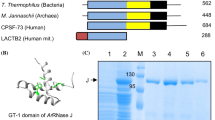Abstract
We have isolated a 1148 bp long cDNA clone encoding an RNA-binding protein in Arabidopsis. Several partial cDNA clones were isolated by screening an Arabidopsis λgt11 expression library for the binding of DNA. One of these clones was used as a probe to isolate a full-length clone. The 329 amino acid protein, termed RNP-T, contains in its carboxy terminus two adjacent RNP-80 motifs, a previously described 80 amino acid long conserved putative RNA-binding domain. Each RNP-80 motif includes both consensus short sequences, RNP1 and RNP2, which are separated by 33 amino acids. We have identified an acidic domain of 54 amino acids, which is located amino-terminal to the RNP-80 motifs. Seven tandem repeats of a hexamer are present within this domain. This acidic domain has a potential α-helix conformation. We propose that the acidic patch might play a role in protein-protein interaction.
Similar content being viewed by others
References
Adam SA, Nakagawa TY, Swanson MS, Woodruff T, Dreyfuss G: mRNA polyadenylate-binding protein: Gene isolation and sequencing and identification of a ribonucleoprotein consensus sequence. Mol Cell Biol 6: 2932–2943 (1986).
Bandziulis RJ, Swanson MS, Dreyfuss G: RNA-binding proteins as developmental regulators. Genes Devel 3: 431–437 (1989).
Choi Y, Dreyfuss G: Monoclonal antibody characterization of the proteins of heterogeneous nuclear ribonucleoprotein complexes in vertebrate cells. J Cell Biol 99: 1997–2004 (1984).
Dreyfuss G, Swanson MS, Pinol-Roma S: Heterogeneous nuclear ribonucleoprotein particles and the pathway of mRNA formation. Trends Biochem Sci 13: 86–91 (1988).
Giuliano G, Pichersky E, Malik VS, Tomko MP, Scolnik PA, Cashmore AR: An evolutionarily conserved protein binding sequence upstream of a plant light-regulated gene. Proc Natl Acad Sci USA 85: 7089–7093 (1988).
Gomez J, Sanchez-Martinez D, Stiefel V, Rigau J, Puigdomenech P, Pages M: A gene induced by the plant hormone abscisic acid in response to water stress encodes a glycine-rich protein. Nature 334: 262–264 (1988).
Haynes SR, Johnson D, Raychaudhuri G, Beyer AL: The Drosophila Hrb87F gene encodes a new member of the A and B hnRNP protein group. Nucl Acids Res 19: 25–31 (1990).
Kenan DJ, Query CC, Keene JD: RNA recognition: Towards identifying determinants of specificity. Trends Biochem Sci 16: 214–220 (1991).
Lapeyre B, Bourbon H, Amalric F: Nucleolin, the major nucleolar protein of growing eukaryotic cells: An unusual protein structure revealed by the nucleotide sequence. Proc Natl Acad Sci USA 84: 1472–1476 (1987).
Leser GP, Escara-Wilke J, Martin TE: Monoclonal antibodies to heterogeneous nuclear RNA-protein complexes. J Biol Chem 259: 1827–1833 (1984).
Li Y, Sugiura M: Three distinct ribonucleoproteins from tobacco chloroplasts: Each contains a unique amino terminal acidic domain and two ribonucleoprotein motifs. EMBO J 9: 3059–3066 (1990).
Luhrmann R, Kastner B, Bach M: Structure of spliceosomal snRNPs and their role in pre-mRNA splicing. Biochim Biophys Acta 1087: 265–292 (1990).
Milburn SC, Hershey JWB, Davies MV, Kelleher K, Kaufman RJ: cloning and expression of eukaryotic initiation factor 4B cDNA: Sequence determination identifies a common RNA recognition motif. EMBO J 9: 2783–2790 (1990).
Pandolfo M, Valentini O, Biamonti G, Rossi P, Riva S: Large-scale purification of hnRNP proteins from HeLa cells by affinity chromatography on ssDNA-cellulose. Eur J Biochem 162: 213–220 (1987).
Pinol-Roma S, Choi YD, Matunis MJ, Dreyfuss G: Immunopurification of heterogeneous nuclear ribonucleoprotein particles reveals an assortment of RNA-binding proteins. Genes Devel 2: 215–227 (1988).
Query CC, Bentley RC, Keene JD: A common RNA recognition motif identified within a defined U1 RNA binding domain of the 70K U1 snRNP Protein. Cell 57: 89–101 (1989).
Sachs AB, Bond MW, Kornberg RD: A single gene from yeast for both nuclear and cytoplasmic polyadenylate-binding proteins: Domains structure and expression. Cell 45: 827–835 (1986).
Sambrook J, Maniatis T, Fritsch EF: Molecular Cloning: A Laboratory Manual, 2nd ed. Cold Spring Harbor Laboratory Press, Cold Spring Harbor, NY (1989).
Sanger F, Nicklen S, Coulson AR: DNA sequencing with chain-termination inhibitors. Proc Natl Acad Sci USA 74: 5463–5467 (1977).
Scherly D, Boelens W, vanVenrooij WJ, Dathan NA, Hamm J, Mattaj IW: Identification of the RNA binding segment of human U1 A protein and definition of its binding site on U1 snRNA. EMBO J 8: 4163–4170 (1989).
Scherly D, Boelens W, Dathan NA, vanVenrooij WJ, Mattaj IW: Major determinants of the specificity of interaction between small nuclear ribonucleoproteins U1A and U2B′' and their cognate RNAs. Nature 345: 502–506 (1990).
Schindler U, Cashmore AR: Photoregulated gene expression may involve ubiquitous DNA binding proteins. EMBO J 9: 3415–3427 (1990).
Schuster G, Gruissem W: Chloroplast mRNA 3′ end processing requires a nuclear-encoded RNA-binding protein. EMBO J 10: 1493–1502 (1991).
Setyono B, Greenberg JR: Proteins associated with poly(A) and other regions of mRNA and hnRNA molecules as investigated by crosslinking. Cell 24: 775–783 (1981).
Swanson MS, Nakagawa TY, LeVan K, Dreyfuss G: Primary structure of human nuclear ribonucleoprotein particle C proteins: Conservation of sequence and domain structures in heterogeneous nuclear RNA, mRNA, and pre-rRNA-binding proteins. Mol Cell Biol 7: 1731–1739 (1987).
Vinson CR, LaMarco KL, Johnson PF, Landschulz WH, McKnight SL: In situ detection of sequence-specific DNA binding activity specified by a recombinant bacteriophage. Genes Devel 2: 801–806 (1988).
Author information
Authors and Affiliations
Rights and permissions
About this article
Cite this article
Bar-Zvi, D., Shagan, T., Schindler, U. et al. RNP-T, a ribonucleoprotein from Arabidopsis thaliana, contains two RNP-80 motifs and a novel acidic repeat arranged in an α-helix conformation. Plant Mol Biol 20, 833–838 (1992). https://doi.org/10.1007/BF00027154
Received:
Accepted:
Issue Date:
DOI: https://doi.org/10.1007/BF00027154




